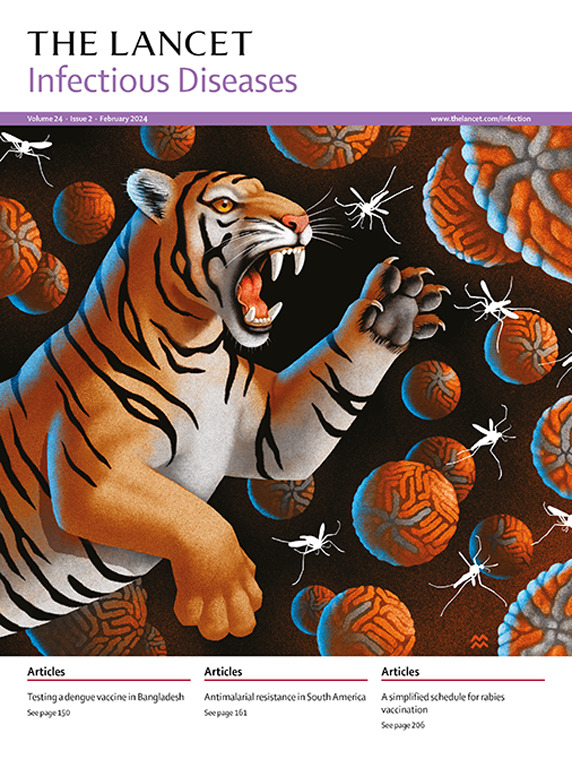Estimated undertreatment of carbapenem-resistant Gram-negative bacterial infections in eight low-income and middle-income countries: a modelling study
IF 36.4
1区 医学
Q1 INFECTIOUS DISEASES
引用次数: 0
Abstract
Background
Carbapenem-resistant Gram-negative (CRGN) bacterial infections are an urgent health threat, especially in low-income and middle-income countries (LMICs), where they are rarely detected and might not be treated appropriately given inadequate health system capacity. To understand this treatment gap, we estimated the total number of CRGN bacterial infections requiring an active agent and the number of individuals potentially initiated on appropriate treatment in eight large LMICs.Methods
For eight selected countries (Bangladesh, Brazil, Egypt, India, Kenya, Mexico, Pakistan, and South Africa), we estimated deaths associated with CRGN bacterial infections (that were not susceptible to other antibiotics) in 2019 using data from the Global Burden of Disease 2021 study on antimicrobial resistance. We used estimates from the literature to establish infection type-specific case fatality rates and an overall case fatality rate for CRGN bacterial infections. The total number of CRGN bacterial infections requiring an active agent could then be calculated by dividing the total number of CRGN bacterial infection-related deaths by the overall case fatality rate. We estimated the treatment gap (ie, the number of individuals with CRGN bacterial infections who were not appropriately treated) by subtracting from the total number of infections the number of individuals who initiated appropriate treatment, which was estimated using 2019 IQVIA sales data for six antibiotics active against CRGN bacteria, corrected to account for IQVIA's partial data coverage for each country and dose-adjusted by age.Findings
In 2019, in the eight selected countries, we estimated that there were 1 496 219 CRGN bacterial infections (95% CI 1 365 392–1 627 047) but that only 103 647 treatment courses were procured. The resulting treatment gap (1 392 572 cases [95% CI 1 261 745–1 523 400]) meant that only 6·9% of patients were treated appropriately. The treatment gap persisted even when we used more restrictive assumptions. The most-procured antibiotic was tigecycline (intravenous; 47 531 [45·9%] of 103 647 courses). India procured most of the treatment courses (83 468 [80·5%] courses), with 7·8% of infections treated appropriately (treatment gap 982 848 cases [95% CI 909 291–1 056 405]). The rates of appropriate treatment coverage were highest in Mexico (5634 [5·4%] courses procured; treatment gap 32 141 cases [30 416–33 867]) and Egypt (7572 [7·3%] courses procured; treatment gap 43 258 cases [38 742–47 774]), both with 14·9% of infections treated appropriately.Interpretation
Infections caused by CRGN bacteria are likely to be significantly undertreated in LMICs. To close this treatment gap, improved access to diagnostics and antibiotics, strengthening of health systems, and research to identify gaps in the treatment pathway are needed.Funding
Global Antibiotic Research and Development Partnership, supported by the Governments of Canada, Germany, Japan, Monaco, the Netherlands, Switzerland, and the UK, and by the Canton of Geneva, the EU, the Bill & Melinda Gates Foundation, Global Health EDCTP3, GSK, the RIGHT Foundation, the South African Medical Research Council, and Wellcome.估计八个低收入和中等收入国家碳青霉烯耐药革兰氏阴性细菌感染治疗不足:一项模拟研究
耐碳青霉烯革兰氏阴性(CRGN)细菌感染是一项紧迫的健康威胁,特别是在低收入和中等收入国家,在这些国家,它们很少被发现,而且由于卫生系统能力不足,可能无法得到适当治疗。为了了解这种治疗差距,我们估计了8个大型中低收入国家中需要活性剂的CRGN细菌感染的总数和可能开始适当治疗的个体数量。方法在选定的8个国家(孟加拉国、巴西、埃及、印度、肯尼亚、墨西哥、巴基斯坦和南非)中,我们使用2021年全球疾病负担抗菌素耐药性研究的数据估计了2019年与CRGN细菌感染(对其他抗生素不敏感)相关的死亡人数。我们使用文献中的估计值来确定特定感染类型的病死率和CRGN细菌感染的总病死率。然后,通过将CRGN细菌感染相关死亡的总数除以总病死率,可以计算出需要活性剂的CRGN细菌感染的总数。我们通过从感染总数中减去开始适当治疗的个体数量来估计治疗差距(即未得到适当治疗的CRGN细菌感染个体数量),这是使用2019年IQVIA对六种抗CRGN细菌活性抗生素的销售数据估计的,并根据IQVIA对每个国家的部分数据覆盖进行了校正,并按年龄进行了剂量调整。2019年,在选定的8个国家中,我们估计有1 496 219例CRGN细菌感染(95% CI 1 365 392-1 627 047),但仅采购了103 647个疗程。由此产生的治疗缺口(1 392 572例[95% CI 1 261 745 - 523 400])意味着只有6.9%的患者得到了适当的治疗。即使我们使用更严格的假设,治疗差距仍然存在。采购最多的抗生素是替加环素(静脉注射;103 647门课程中有47 531门(占45.9%)。印度获得了大多数疗程(83468[83.5%]个疗程),其中7.8%的感染得到了适当治疗(治疗差距为982848例[95% CI 909 291-1 056 405])。墨西哥的适当治疗覆盖率最高(获得5634个疗程[5.4%]);治疗缺口32 141例[30 416-33 867])和埃及(7572例[7.3%]疗程);治疗差距43 258例[38 742-47 774]),两者均有14.9%的感染得到适当治疗。在中低收入国家中,由CRGN细菌引起的感染很可能严重治疗不足。为了缩小这一治疗差距,需要改善诊断和抗生素的可及性,加强卫生系统,并开展研究以确定治疗途径中的差距。全球抗生素研究与开发伙伴关系得到加拿大、德国、日本、摩纳哥、荷兰、瑞士和英国政府以及日内瓦州、欧盟、世卫组织和世卫组织的支持。梅琳达·盖茨基金会、全球卫生EDCTP3、葛兰素史克、RIGHT基金会、南非医学研究理事会和惠康基金会。
本文章由计算机程序翻译,如有差异,请以英文原文为准。
求助全文
约1分钟内获得全文
求助全文
来源期刊

Lancet Infectious Diseases
医学-传染病学
CiteScore
60.90
自引率
0.70%
发文量
1064
审稿时长
6-12 weeks
期刊介绍:
The Lancet Infectious Diseases was launched in August, 2001, and is a lively monthly journal of original research, review, opinion, and news covering international issues relevant to clinical infectious diseases specialists worldwide.The infectious diseases journal aims to be a world-leading publication, featuring original research that advocates change or sheds light on clinical practices related to infectious diseases. The journal prioritizes articles with the potential to impact clinical practice or influence perspectives. Content covers a wide range of topics, including anti-infective therapy and immunization, bacterial, viral, fungal, and parasitic infections, emerging infectious diseases, HIV/AIDS, malaria, tuberculosis, mycobacterial infections, infection control, infectious diseases epidemiology, neglected tropical diseases, and travel medicine. Informative reviews on any subject linked to infectious diseases and human health are also welcomed.
 求助内容:
求助内容: 应助结果提醒方式:
应助结果提醒方式:


